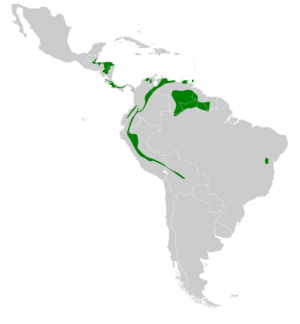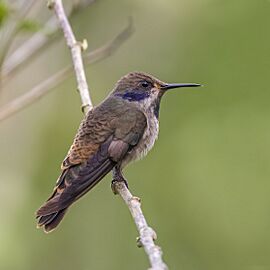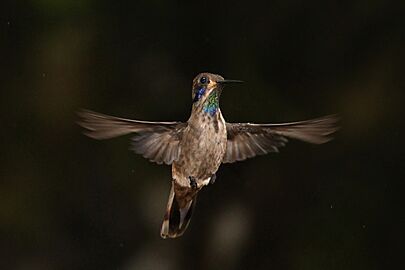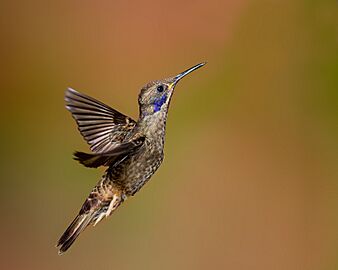Brown violetear facts for kids
Quick facts for kids Brown violetear |
|
|---|---|
 |
|
| Showing green gorget | |
| Conservation status | |
| Scientific classification | |
| Genus: |
Colibri
|
| Species: |
delphinae
|
 |
|
| Synonyms | |
|
Ornismya Delphinae (protonym) |
|
The brown violetear (Colibri delphinae) is a large and beautiful hummingbird. It lives in the mountains of Central America and South America. You can also find it in Trinidad and parts of Brazil. This bird is known for its dull brown feathers and a special violet patch near its eye.
Contents
About the Brown Violetear
The brown violetear is about 11.5 centimeters (4.5 inches) long. It weighs around 6.5 to 7 grams. That's about the same weight as a few paper clips!
What it Looks Like
This hummingbird is mostly dull brown. It has a reddish-brown area on its back, near its tail. Its belly is a bit greyer. A cool violet patch runs from its eye downwards. It also has a shiny green and blue stripe on its throat. Its beak is quite short and straight.
Males and Females
Female brown violetears look a lot like the males. However, their throat patch is usually smaller. Young birds have reddish-brown edges on their top feathers. They also have very little or no violet color behind their eyes.
Where it Lives
Brown violetears like to live in forests. They are found at heights between 400 and 1600 meters (about 1,300 to 5,200 feet). When they are not nesting, they might fly down to lower areas. You can often spot them high up in the trees of rainforests. They also live in areas where new trees are growing or in coffee farms. They might fly lower to find food at the edges of forests or in clearings.
Nesting Habits
Brown violetears build a small, cup-shaped nest. They make it from soft plant material. The nest is placed on a twig in a bush, usually 1 to 3 meters (3 to 10 feet) off the ground. The female lays two white eggs in the nest.
What it Eats
Like most hummingbirds, the brown violetear loves to drink nectar. It gets nectar from small flowers on trees, shrubs, and plants that grow on other plants (called epiphytes). They also eat insects. Insects are an important source of protein for them. They often catch insects while flying, which is called "hawking."
Bird Behavior
Brown violetears are not very territorial. This means they don't always defend their feeding spots strictly. However, they can be quite aggressive. If you see them at a bird feeder, they might spend more time chasing other hummingbirds than actually eating!
Its Voice
The brown violetear has a strong and clear song. It sounds like a repeated "chit" call. Many male birds will sing together in groups. These groups are called leks.






